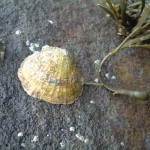Andrew J. Davies, Mark P. Johnson, Christine A. Maggs
Published in Marine Ecology-Progress Series (2008)
 Limpets, predominantly Patella vulgata, have been associated with damaged or receding canopies of Ascophyllum nodosum. Although the damage results from limpet grazing, the benefits that limpets gain from this behaviour are unclear as A. nodosum is thought to be well defended from grazers by anti-herbivore compounds. In this study, P. vulgata individuals were enclosed at densities between 80 and 320 m-2 at two sites within Strangford Lough. Limpet growth and limpet survival were compared between unsubsidised controls and treatments in which limpet diets were subsidised by fronds of A. nodosum. When subsidised, limpet residual growth rates were significantly higher and mortality was lower than in unsubsidised control treatments. Individual limpets consumed a similar amount of A. nodosum regardless of limpet density. Higher densities of limpets therefore consumed more A. nodosum per replicate. The effects of A. nodosum in maintaining limpet densities could resonate through sheltered rocky communities. The importance of a macroalgal subsidy in supporting limpet populations may have been underestimated or overlooked in earlier studies. Therefore, the extensive and productive macroalgal canopies that characterise many sheltered temperate rocky shores could be more sensitive to increased limpet abundances than previously thought.
Limpets, predominantly Patella vulgata, have been associated with damaged or receding canopies of Ascophyllum nodosum. Although the damage results from limpet grazing, the benefits that limpets gain from this behaviour are unclear as A. nodosum is thought to be well defended from grazers by anti-herbivore compounds. In this study, P. vulgata individuals were enclosed at densities between 80 and 320 m-2 at two sites within Strangford Lough. Limpet growth and limpet survival were compared between unsubsidised controls and treatments in which limpet diets were subsidised by fronds of A. nodosum. When subsidised, limpet residual growth rates were significantly higher and mortality was lower than in unsubsidised control treatments. Individual limpets consumed a similar amount of A. nodosum regardless of limpet density. Higher densities of limpets therefore consumed more A. nodosum per replicate. The effects of A. nodosum in maintaining limpet densities could resonate through sheltered rocky communities. The importance of a macroalgal subsidy in supporting limpet populations may have been underestimated or overlooked in earlier studies. Therefore, the extensive and productive macroalgal canopies that characterise many sheltered temperate rocky shores could be more sensitive to increased limpet abundances than previously thought.
Request PDF
| To request a PDF copy of this paper, please enter your email address below: Your email address is not stored, it is only used to send an email with an attached PDF to you. |
Full citation
Davies, A.J., Johnson, M.P. & Maggs, C.A. (2008) “Subsidy by Ascophyllum nodosum increases growth rate and survivorship of Patella vulgata” Marine Ecology Progress Series, 366: 43-48.
